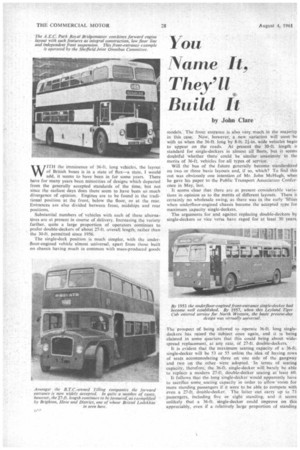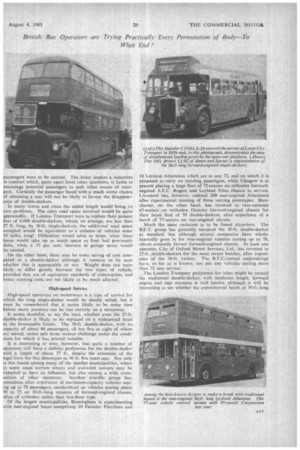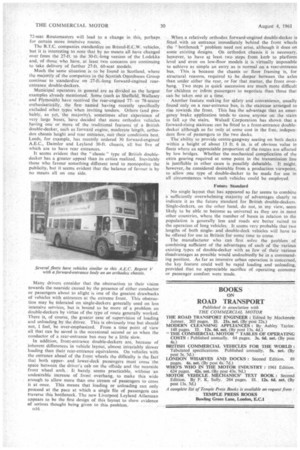You Name It, They'll Build It
Page 58

Page 59

Page 60

If you've noticed an error in this article please click here to report it so we can fix it.
by John Clare
W1T}1 the imminence of .36-ft, long vehicles, the layout of British buses is in a state of flux—a state, I would add, it seems to have been in lot some years. There have for many years been minorities of designs which departed from the 'generally accepted standards of the time, but not since the earliest days does there seem to have been so much divergence of opinion. Engines are to be found in the traditional position at the front, below the floor, or at the rear. Entrances are also divided between front, midships and rear positions.
Substantial numbers of vehicles with each of these alternatives are at present in course of delivery, increasing the variety further, quite a large proportion of operators continues to prefer double-deckers of about 27-ft. overall length, rather than the 30-ft. permitted since 1956.
The single-deck position is much simpler, with the underfloor-engined vehicle almost universal, apart from those built on chassis having much in common with mass-produced goods models, The front entrance is also very much in the majority in this case, Now, however, a new variation will soon be with us when the 36-ft. long by 8-ft.21-in. wide vehicles begin to appear on the roads. At present the 30-ft. length standard for single-deckers' in almost all fleets, but it seems doubtful whether there could be similar unanimity in thc merits of 36-ft. vehicles for all types of service. .
Will the bus of the future generally become standardized on two or three basic layouts and, if so, which? To find this out was obviously one intention of Mr. John McHugh, when he gave his paper to the Public Transport Association Conference in May, last.
It seems clear that there are at present considerable variations in opinion as to the merits of different layouts. There is certainly no wholesale swing, as there was in the early 'fifties when underfloor-engined chassis became the accepted type for maximum capacity single-deckers.
The arguments for and against replacing double-deckers by single-deckers or vice versa have raged for at least 30 years.
The -prospect of being allowed to operate 36-ft. long singledeckers has raised the sitbject once again, and it is being claimed in some quarters that this could bring about widespread replacement,. at any rate, Of 27-ft, double-deckers.
It is evident that the maximum seating capacity of a 36-ft, single-decker will be 53 or 55 unless the.idea of having rows of seats accommodating three on one side. of the' gangway and two on the other Were adopted. In terms of seating capacity, therefore,the.36-ft. single-decker will barely be able to replace a modern 27-ft. double-decker seating at least 60.
It follows that the long single-decker would apparently have to sacrifice some seating capacity in order to allow room for more standing passengers if it were to be able to compete, with even a 27-ft. double-decker. The latter can carry up to 73 passengers, including five or eight standing, and it seems unlikely that a 36-ft. single-decker could improve on this appreciably, even if a relatively large proportion of standing
passengers were to be carried. The latter implies a reduction in comfort which, quite apart from other questions, is liable to encourage potential passengers to seek other means of transport. Certainly the passenger faced with a much worse chance of obtaining a seat will not be likely to favour the disappearance of double-deckers.
In many towns and cities the added length would bring its own problems. The extra road space involved would be quite appreciable, If London Transport were to replace their present fleet of 6,000 double-deckers, which, on average, are less than 27 ft. long, by 36-ft. single-deckers, the additional road space occupied would be equivalent to a column of vehicles some 10 miles long! Difficulties would arise at stops, since three buses would take up as much space as four had previously done, white a 33 per cent. increase in garage space would be needed.
On the other hand, there may be some saving of cost compared to a double-decker although it remains to be seen whether this is appreciable or not. Weight does not seem likely to differ greatly between the two types of vehicle, provided they are of equivalent standards of construction, and hence running costs are not likely to be much affected.
High-speed Service
High-speed operation on motorways is a type of service for which the long single-decker would be ideally suited, but it must be remembered that it seems likely to be some time before many journeys can be run entirely on a motorway.
It seems doubtful. to say the least, whether even the 27-ft. double-decker is likely to be replaced on a widespread basis in the foreseeable future. The 30-ft, double-decker, with its capacity of about 80 passengers, all but five or eight of whom arc seated, seeins safe from serious challenge under the conditions for which it has proved suitable.
It is interesting to note, however, that quite a number of operators still have a definite preference for the double-decker with a length of about 27 ft., despite the extension of the legal limit for this dimension to 30 ft. five years ago. Not only is this found among many of the smaller municipalities, where in some cases narrow streets and awkward corners may be expected to have an influence, but also among a wide crosssection of other operators. Another sizeable group has. sometimes after experience of maximum-capacity vehicles seating up to 78 passengers, standardized on vehicles seating about 70 to 73 on 30-ft.-long versions of forward-engined chassis. often of orthodox rather than low-floor type.
Of the largest municipalities, Birmingham is experimenting with rear-engined buses comprising Kt Daimler Fleetlines and 10 Leyland Atlanteans which are. to scat 72, and on which it is proposed to carry no standing passengers, while Glasgow is at present placing a large fleet of 72-seaters on orthodox forwardengined A.E.C. Regent and Leyland Titan chassis in service. Liverpool has however, ordered 200 rear-engined Attanteans after experimental running of three varying prototypes. Manchester, on the other hand, has reverted to rear-entrance 65-seaters on orthodox Daimler forward-engined chassis for their latest fleet of 50 double-deckers, after experience of a batch of 77-seaters on rear-engined chassis.
Much the same variation is to be found elsewhere. The B.E.T. group has generally accepted the 30-ft. double-decker as standard, but although several companies have wholeheartedly gone in for rear-engined vehicles seating up to 78, others evidently favour forward-engined chassis. At least one operator, City of Oxford Motor Services, Ltd., has reverted to 27-ft. idouble-deckers for the most recent batches, after experience of the 30-ft. variety. The B.T.C.-owned undertakings have, so far as is known, not put any vehicles seating more than 72 into service.
The London Transport preference for what might be termed the traditional double-decker, with moderate length, forward engine and rear entrance is well known. although it will be interesting to see whether the experimental batch of 30-ft.-long 72-seat Routemasters will lead to a change in this, perhaps for certain more intensive routes.
The R.T.C. companies standardize on Bristol-E.C.W. vehicles, but it is interesting to note that by no means all have changed over from the 27-ft. to the 30-ft.-long version of the Lodekka and, of those who have, at least two concerns are continuing to take delivery of further 27-ft. 60-seat models.
Much the same situation is to be found in Scotland, where the majority of the companies in the Scottish Omnibuses Group continue to standardize on 27-ft.-long forward-engined rearentrance double-deckers.
Municipal operators in general are as divided as the largest examples already mentioned. Some (such as Sheffield, Wallasey and Plymouth) have received the rear-engined 77or 78-seater enthusiastically, the first • named having recently specifically rexcluded other types when inviting tenders. Others (and probably, as yet, the majority), sometimes after experience of very large buses, have decided that more orthodox vehicles having -one or more of the traditional features of a British double-decker, such as forward engine, moderate length, orthodox chassis height and rear entrance, suit their conditions best. Leeds, for example, has recently ordered 30 forward-engined A.E.C., Daimler and Leyland 30-ft. chassis, all but five of which are to have rear entrances.
It seems evident that the "classic" type of British doubledecker has a greater appeal than its critics realized. Inevitably those Who favour something different tend to monopolize the publicity, but it seems evident that the balance of favour is by no means all on one side.
Many drivers consider that the obstruction to their vision towards the nearside caused by the presence of either conductor or passengers about to alight is one of the greatest drawbacks of vehicles with entrances at the extreme front. This obstruction may be tolerated on single-deckers generally used on less intensive services, but is bound to be more of a problem on double-deckers by virtue of the type of route generally worked. There is, of course, the greater case of supervision of loading and unloading by the driver. This is obviously true but should not, I feel, be over-emphasized. From a time point of view all that can be saved is the occasional second or so when the conductor of a rear-entrance bus may be a little slow.
In addition, front-entrance double-deckers are, because of inherent differences in vehicle layout, almost invariably slower loading than their rear-entrance equivalents. On vehicles with the entrance ahead of the front wheels the difficulty is the fact that both upperand lower-deck passengers must cross the space between the driver's cab on the offside and the nearside front wheel arch. It barely seems practicable, without an undesirable increase of front overhang, to make this wide enough to allow more than one stream of passengers to cross it at once. This means that loading or unloading can only proceed at the pace at which a single file of passengers can traverse this bottleneck. The new Liverpool Leyland Atlantean appears to be the first design of this layout to show evidence of serious thought being given to this problem.
1.)16 When a relatively orthodox forward-engined double-decker is fitted with an entrance immediately behind the front wheels the " bottleneck " problem need not arise, although it does on some existing designs. On orthodox chassis it is necessary, however, to have at least two steps from kerb to platform level and even on low-floor models it is virtually impossible to achieve as simple an entry as is normal on a rear-entrance bus. This is because the chassis or floor framing is, for structural reasons, required to be deeper between the axles than under either the rear, or for that matter, the front overhang. Two steps in quick succession are much more difficult for children or infirm passengers to negotiate than those that can be taken one at a time.
Another feature making for safety and convenience, usually found only on a rear-entrance bus, is the staircase arranged to rise towards the front. This has the advantage that an emergency brake application tends to cause anyone on the stairs to fall up the stairs. Walsall Corporation has shown that a forward-rising staircase can be fitted to a front-entrance doubledecker although so far only at some cost in the free, independent flow of passengers to the two decks.
The ability to provide centre-gangway seating on both decks within a height of about 13 ft. 6 in. is of obvious value in fleets where an appreciable proportion of the routes are affected by low bridges. Whether the mechanical complication of the extra gearing required at some point in the transmission line is justifiable in other cases is possibly debatable. It might, however, .be considered desirable from a production view-point, to allow one type of double-decker to be made for use in all circumstances where such vehicles could be employed.
Future Standard
No single layout that has appeared so far seems to combine a sufficiently overwhelming majority of advantages clearly to indicate it as the future standard for British double-deckers. Single-deckers, on the other hand, do not, in my view, seem likely to be able to become as universal as they are in most other countries, where the number of buses in relation to the population is generally less and roads are better -suited to the operation of long vehicles. It seems very probable that two lengths of both singleand double-deck vehicles will have to be offered for use in Britain for some time to come.
The manufacturer who can first solve the problem of combining sufficient of the advantages of each of the various existing types of double-decker with as few of their various disadvantages as possible would undoubtedly be in a commanding position. As far as intensive urban operation is concerned, the key feature could well be rapid loading and unloading, provided that no appreciable sacrifice of operating economy or passenger comfort were made.








































































































